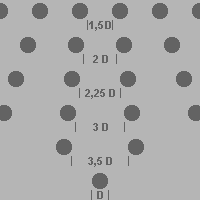Intercolumnium
The clear distance between the individual columns of a row of columns is referred to as the intercolumnium , whereas the distance between the column axes is referred to as the axis width or yoke .
Furthermore, in written texts, the distance between two columns can be identified.
The Roman architectural theorist Vitruvius distinguishes five round ratios of the intercolumnium to the lower column diameter, with different aesthetic effects:
- pyknostylos, narrow column or dense column: intercolumn = 1 ½ column diameter (Dm)
- systylos, stretched: intercolumn = 2 dm
- eustylos, beautiful columnar: intercolumn = 2 ¼ Dm
- diastylous, wide columnar: intercolumnium = 3 dm
- areostylos, pillar of light: intercolumn = 3 ½ dm
The lower column diameter is decisive. This dimension is beyond doubt on Doric columns, which have no base . In the case of columns with bases, i.e. Ionic and Corinthian , it is, however, disputed at which point the lower column diameter is determined. According to the majority view, this is the point immediately above the approach profile , that is, where the convex curved section of the surface line at the lower end of the column shaft merges into the straight or concave (ie with entasis ) curved section. Notwithstanding this, a somewhat larger dimension, namely the plate on the run-up profile, is proposed.
In the architecture of Greek and Roman antiquity , great importance is attached to the relationship between the individual components. The distance between the columns has a major effect on how light or closed or how fragile or solid a building appears.
